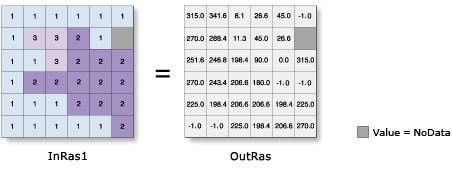Available with Spatial Analyst license.
Summary
Derives aspect from a raster surface. The aspect identifies the downslope direction of the maximum rate of change in value from each cell to its neighbors.
Aspect can be thought of as the slope direction. The values of the output raster will be the compass direction of the aspect.
Illustration

Usage
Aspect is the direction of the maximum rate of change in the z-value from each cell in a raster surface.
Aspect is expressed in positive degrees from 0 to 359.9, measured clockwise from north.
Cells in the input raster that are flat—with zero slope—are assigned an aspect of -1.
If the center cell in the immediate neighborhood (3 x 3 window) is NoData, the output is NoData.
If any neighborhood cells are NoData, they are first assigned the value of the center cell, then the aspect is computed.
When the input raster needs to be resampled, the Bilinear technique will be used. An example of when an input raster may be resampled is when the output coordinate system, extent, or cell size is different from that of the input.
See Analysis environments and Spatial Analyst for additional details on the geoprocessing environments that apply to this tool.
Syntax
Aspect (in_raster)
| Parameter | Explanation | Data Type |
in_raster |
The input surface raster. | Raster Layer |
Return Value
| Name | Explanation | Data Type |
| out_raster | The output aspect raster. It will be floating point type. | Raster |
Code sample
Aspect example 1 (Python window)
This example creates an aspect raster from an input surface raster.
import arcpy
from arcpy import env
from arcpy.sa import *
env.workspace = "C:/sapyexamples/data"
outAspect = Aspect("elevation")
outAspect.save("C:/sapyexamples/output/outaspect01.img")
Aspect example 2 (stand-alone script)
This example creates an aspect raster from an input surface raster.
# Name: Aspect_Ex_02.py
# Description: Derives aspect from a raster surface.
# Requirements: Spatial Analyst Extension
# Import system modules
import arcpy
from arcpy import env
from arcpy.sa import *
# Set environment settings
env.workspace = "C:/sapyexamples/data"
# Set local variables
inRaster = "elevation"
# Check out the ArcGIS Spatial Analyst extension license
arcpy.CheckOutExtension("Spatial")
# Execute Aspect
outAspect = Aspect(inRaster)
# Save the output
outAspect.save("C:/sapyexamples/output/outaspect02")
Environments
Licensing information
- ArcGIS Desktop Basic: Requires Spatial Analyst or 3D Analyst
- ArcGIS Desktop Standard: Requires Spatial Analyst or 3D Analyst
- ArcGIS Desktop Advanced: Requires Spatial Analyst or 3D Analyst